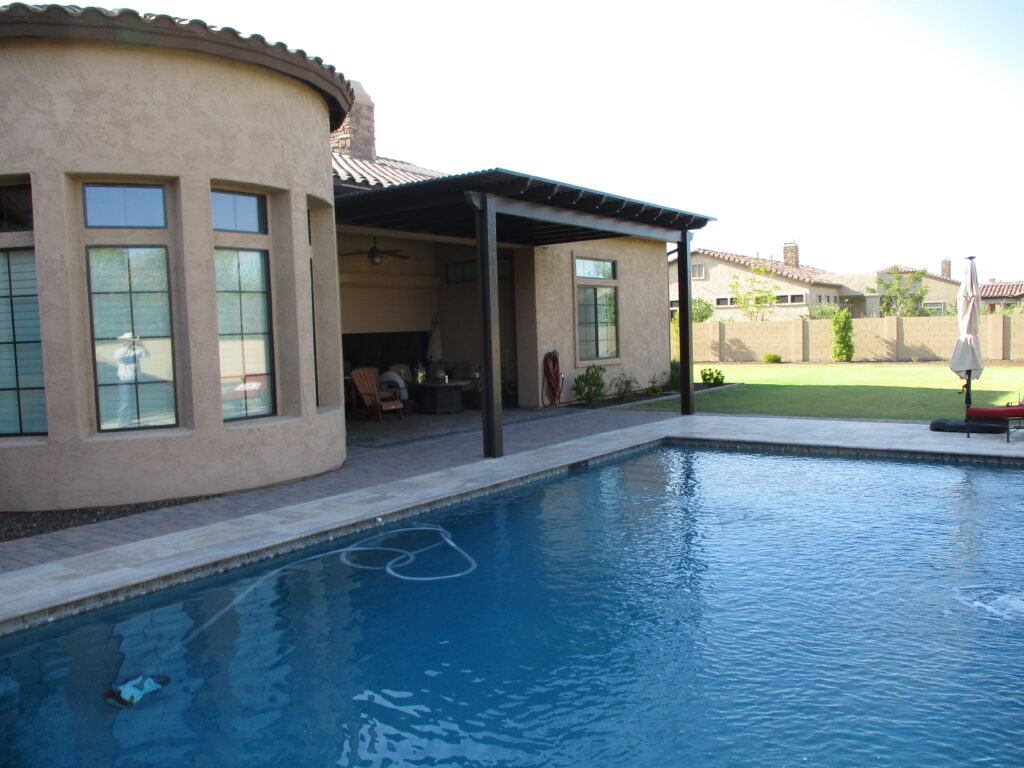Picture this: You’re standing in your backyard, squinting against the harsh Arizona sun. The space is wide open, begging to be used, but it’s just way too hot. You can almost see the potential – family gatherings, quiet mornings with coffee, or even a cozy spot for your dog to lounge. But right now, it’s a no-man’s land of heat and glare.
Sound familiar? If you’re nodding your head, you’re not alone. Many Phoenix homeowners find themselves in this exact situation, dreaming of a shaded oasis but unsure where to start. You might be wondering, “Can I even build a pergola attached to my house? And if so, what’s involved?”
Well, grab a cold drink and get comfy, because we’re about to dive into everything you need to know about attaching pergolas to your home. By the end of this article, you’ll understand:
- Whether building a pergola attached to your home is possible (spoiler alert: it usually is!)
- The different types of pergolas available, with a focus on Alumawood
- The pros and cons of attached vs. freestanding pergolas
- What’s involved in the installation process
- Important considerations for your specific home and needs
- How to choose the right professional for the job
Let’s get started!
The Dream of Shade and Style: Why Homeowners Want Pergolas
First things first – let’s talk about why you’re probably reading this article. As Arizonans, we know the struggle. Our backyards are full of potential, but that relentless sun makes it tough to enjoy them for a good chunk of the year.
You’ve probably had moments where you’ve thought:
- “I wish I could sit outside without feeling like I’m melting.”
- “It’d be nice to have a partially shaded area for entertaining.”
- “My garden could use a beautiful structure for climbing plants.”
- “Wouldn’t it be great to extend our living space outdoors with some architectural flair?”
We get it. And we’re here to tell you that yes, you can make that stylish, shaded backyard oasis a reality with a pergola. But before we get into the nitty-gritty, let’s address the big question:

Can You Actually Build a Pergola Attached to Your Home?
The short answer? In most cases, yes!
Building a pergola attached to your home is not only possible but often preferred by many homeowners. It creates a seamless transition between your indoor and outdoor spaces, can offer a striking architectural element, and often looks more integrated with your home’s design.
However (you knew there’d be a “however,” right?), there are some important factors to consider:
- Your Home’s Structure: The construction of your home plays a big role. Some houses are better suited for attached pergolas than others.
- Local Building Codes: Every city has its own rules about what you can build and how. In Phoenix, for example, you’ll need to check with the city’s Planning and Development Department.
- HOA Regulations: If you live in a neighborhood with a Homeowners Association, you’ll need to make sure your plans align with their guidelines.
- Your Budget: Attached pergolas can sometimes be more expensive than freestanding ones, depending on the complexity of the installation.
- Your Goals: What do you want to use the space for? This can influence whether an attached or detached pergola is better for you.
Now that we’ve established that yes, you probably can attach a pergola to your home, let’s talk about your options.
Types of Pergolas: Spotlight on Alumawood
There are several materials you can use for a pergola, including wood, vinyl, and aluminum. But today, we’re going to focus on our specialty: Alumawood pergolas.
Alumawood is a type of aluminum outdoor structures that look like wood but offer the durability of metal. Here’s why we love them (and why our customers do too):
- Low Maintenance: Unlike wood, Alumawood doesn’t rot, warp, or attract termites. A simple wash now and then keeps it looking great.
- Durability: These pergolas stand up to Arizona’s harsh sun and occasional storms like champs.
- Customizable: Want the look of a rustic wood beam? Or maybe a sleek, modern style? Alumawood comes in various colors and styles to match your home.
- Versatile Shade Options: You can add retractable canopies or leave it open for climbing plants.
- Cost-Effective: While the upfront cost might be higher than some options, the longevity and low maintenance make it a smart long-term investment.
Pergola Attached vs. Freestanding: The Great Debate
Now, you might be wondering: “If I can build a pergola attach it to my house, why wouldn’t I?” Good question! Let’s break down the pros and cons:
Pergolas Attached
Pros:
- Create a seamless indoor-outdoor transition
- Often more stable and durable
- Can enhance your home’s architectural appeal
- Usually more aesthetically pleasing
Cons:
- May require more complex permitting
- Can be more expensive to install
- Potential for water damage if not installed correctly
Pergolas Freestanding
Pros:
- More flexibility in placement
- Often easier to get permits for
- Can be moved or modified more easily
- Might be a better option for certain yard layouts
Cons:
- Less protection from wind
- Might not feel as integrated with your home
- Could take up more yard space
In our experience at Chillax Patios, many homeowners prefer a pergola attached to their house. They just feel more like an extension of the home. But every situation is unique, and sometimes a freestanding structure is the way to go.
The Nitty-Gritty: How Are Pergolas Attached to Homes
Okay, let’s get into the fun stuff (well, fun for us pergola nerds, anyway). How does this actually work?
Building a pergola attached to your home involves several key steps:
- Assessment: First, we take a good look at your home’s structure. We’re checking out the roof line, wall construction, and any potential obstacles.
- Design: Based on the assessment, we create a design that complements your home and meets your needs.
- Ledger Board Installation: This is the backbone of building a pergola attached to your home. It’s a strong board securely fastened to your home’s frame.
- Flashing: This is crucial! Proper flashing prevents water from seeping between the pergola and your home.
- Support Post Installation: These go into the ground and support the outer edge of your pergola.
- Beam and Rafter Installation: Finally, we install the Alumawood beams and rafters to create your new partially shaded paradise.
Each of these steps requires precision and expertise. That’s why it’s so important to work with professionals who know their stuff (like us – shameless plug, we know, but hey, we’ve been doing this for 8+ years!).
Important Considerations for Your Home
Before you get too excited and start picking out outdoor furniture, there are a few things to think about:
- Roof Line: The shape and height of your roof can affect how (and if) a pergola can be attached.
- Existing Features: Things like windows, doors, and outdoor lighting need to be factored into the design.
- Sun Exposure: The direction your pergola faces affects how much shade you’ll get at different times of day.
- Plant Life: If you’re planning to grow vines or other climbing plants on your pergola, we need to plan for that.
- Future Plans: Thinking of adding outdoor kitchen down the line? Let’s plan for that now.
Choosing the Right Professional
Look, we know we’re not the only pergola installers in Phoenix. And while we’d love your business, what we really want is for you to have a pergola you love, installed safely and correctly. So here’s what to look for in a professional:
- Experience: How long have they been installing pergolas? Have they worked with Alumawood before?
- Licensing and Insurance: This is non-negotiable. Make sure they’re properly licensed for your area.
- References: Don’t be shy – ask for references and actually call them!
- Clear Communication: Do they explain things in a way you understand? Are they responsive to your questions?
- Detailed Quotes: The estimate should break down costs and be clear about what’s included.
- Warranty: What kind of warranty do they offer on their work?
At Chillax Patios, we tick all these boxes (and then some), but don’t just take our word for it. Do your homework and choose a company you feel comfortable with.
The Bottom Line
So, can you build a pergola attached to your home? In most cases, absolutely! And if you’re in the Phoenix area, an Alumawood pergola attached to your home could be the perfect solution to turn your sun-baked backyard into a cool, inviting oasis with a touch of style.
Remember, every home is unique, and what works for your neighbor might not be the best choice for you. That’s why it’s so important to work with experienced professionals who can guide you through the process.
We hope this article has given you a good starting point for your pergola journey. If you have more questions (and we bet you do – this stuff can get complicated!), don’t hesitate to reach out. We’re always happy to chat about pergolas, no strings attached.
And hey, even if you don’t end up working with us, we hope you’ll send us a picture of your finished pergola. There’s nothing we love more than seeing Phoenix homeowners enjoying their outdoor spaces. Well, except maybe a cold drink under a beautiful pergola on a hot Arizona day. But that’s a close second.
Stay cool out there, Phoenix!

